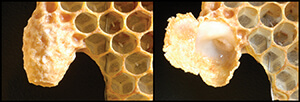Archived Columns
Who Gets to be Queen?

When it comes to dramatic plot devices, it’s hard to beat royal succession, or at least when it goes bad. What would our literature, theater, and cinema be without it? Think Macbeth; think Antony and Cleopatra; War of the Roses; Brave Heart – and of course the pop phenom, Game of Thrones. Yes, in all our recorded history we humans have shown a consistent and insatiable lust for power and influence and a willingness to fight for it. For much of our history, that power and influence has been nested in royalty or in more recent centuries, political leadership. One doesn’t have to look far to find the same motives alive and well in our present political systems.
It’s also not hard to read the same possibilities in the honey bee colony. The annual cycle of colony swarming makes annual requeening a near certainty, and that doesn’t even count supersedures or emergency replacements. When the dust settles after a chaotic swarming season, we can expect one strong overwintered colony to have produced maybe two new swarm colonies. Out of all available female larvae in the colony, only about 20 were reared to mature queen cells, of which only two (in our example) resulted in new successful queens. Why those two queens? What, if any, kind of choices were being made by worker bees, and at how many critical junctures?
One thing that differs in the honey bee colony is the reward. The Big Prize is nothing so mundane as the right to wield authority over others. The currency that matters – the only currency that matters in natural selection – is the ability to pass one’s genes on to the next generation. Moreover, in a genetic system as complicated as a honey bee colony, there can be varying degrees of success, and of honey bees, especially a worker, we can ask How many of her genes can she pass on? Which life strategy optimizes her gene transmission? As long-time readers of this column know, workers can make choices that permit more, or fewer, of their genes to be directly passed along. And this raises another big difference between honey bee societies and our own: whereas our species seems to have no compunction against violent enforcement of self-interest, in honey bees, natural selection has moderated the most selfish impulses of workers so that the vast majority of them settle for less than optimum personal reproduction in favor of supporting their queen.
So yes, royal succession in the honey bee colony is messy, but there’s also no getting around it that being queen is the biggest prize of all. Only the queen has unfettered gene transmittal – 50% of her genes with every one of her ~2,000 eggs per day at peak season plus the whole colony’s workforce mobilized to help her in the effort. Out of all the viable female larvae in a colony (see Figure), what evolutionary constraints and opportunities tip the destiny of any of them into becoming the next queen?
The very reason we pose the question this way – Who gets to be queen? – presupposes the possibility for disagreement among workers. Readers will remember that the genetic structure of honey bees makes for some unusual degrees of relation under one roof (see March 2015 column). Male bees have only one set of chromosomes, not the normal two, and this, coupled with the fact that the queen mates with 12-20 drones and stores and uses their sperm for the rest of her life, means that a normal bee colony is made up of numerous subfamilies, each with its own father. Workers in the same subfamily are supersisters and share 75% of their genes in common. Workers in different subfamilies are subsisters and share only 25% of their genes in common. Kin selection theory predicts that these “relatedness asymmetries” will lead to workers preferentially rearing their own supersister larvae into the next queen, if given the chance. Kin-favoring behavior like this is called nepotism, and nepotism in its various expressions has been one of the most appealing and intuitive predictions of kin selection theory. A literature search for the keywords “nepotism, Apis mellifera” yields no fewer than 628 hits.
All of which makes it seem a little odd for me to say that the search for nepotism has come up short. Nepotism is weakly evident, or missing altogether. At least when it comes to queen succession which, one would think, is the most likely place one would find it. Among those 628 papers, queen succession has been a prominent topic, and the weight of evidence is inescapable: nepotism plays a negligible to non-existent role; workers do not preferentially rear supersisters into the next queen.
To flesh this out a little better, let me list some of the ways …


